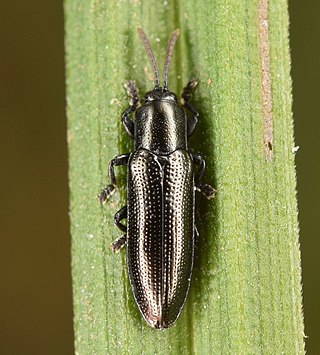
The Cassidinae are a subfamily of the leaf beetles, or Chrysomelidae. The antennae arise close to each other and some members have the pronotal and elytral edges extended to the side and covering the legs so as to give them the common name of tortoise beetles. Some members, such as in the tribe Hispini, are notable for the spiny outgrowths to the pronotum and elytra.

The Cassidini are a tribe within the leaf beetle subfamily Cassidinae. The Cassidini comprises approximately 40 genera worldwide, and is one of the largest tribes in the subfamily, containing most of the genera and species known collectively as "tortoise beetles". The subfamily names Cassidinae and Hispinae were both founded by Gyllenhal in the same 1813 book, but following the Principle of the First Reviser, Chen in this case, priority is given to the name Cassidinae.

Cassida is a large Old World genus of tortoise beetles in the subfamily Cassidinae. The natural history of Cassida sphaerula in South Africa is a typical life cycle. Several species of Cassida are important agricultural pests, in particular C. vittata and C. nebulosa on sugar beet and spinach. The thistle tortoise beetle has been used as a biological control agent against Canada thistle.
Parorectis sublaevis is a species of tortoise beetle in the family Chrysomelidae. It is found in Central America and North America.

Stenispa metallica is a species of tortoise beetle or hispine in the family Chrysomelidae. It is found in Central America and North America.
Parorectis is a genus of tortoise beetles in the family Chrysomelidae. There are at least three described species in Parorectis.
Brachycoryna is a genus of tortoise beetles and hispines in the family Chrysomelidae. There are seven described species in Brachycoryna.

Glyphuroplata is a genus of tortoise beetles and hispines in the family Chrysomelidae. There are at least four described species in Glyphuroplata.
Anisostena is a genus of tortoise beetles and hispines in the family Chrysomelidae. There are at least 30 described species in Anisostena.
Stenopodius is a genus of tortoise beetles and hispines in the family Chrysomelidae. There are about seven described species in Stenopodius.

Odontota is a genus of tortoise beetles and hispines in the family Chrysomelidae. There are about nine described species in Odontota.

Charidotella is a genus of tortoise beetles in the family Chrysomelidae. There are at least 100 described species in Charidotella.

Physonota is a genus of tortoise beetles and hispines in the family Chrysomelidae. There are more than 40 described species in Physonota.

Ischyrosonychini is a tribe of tortoise beetles and hispines in the family Chrysomelidae. There are about 7 genera and at least 70 described species in Ischyrosonychini.
Hilarocassis is a genus of tortoise beetles and hispines in the family Chrysomelidae. There are about 10 described species in Hilarocassis.

Hemisphaerota is a genus in the subfamily Cassidinae in the family Chrysomelidae. There are about 10 described species in Hemisphaerota.

Hemisphaerotini is a Neotropical tribe of tortoise beetles and hispines in the family Chrysomelidae. There are at least 2 genera and more than 40 described species in Hemisphaerotini.

Microrhopala is a genus of tortoise beetles and hispines in the family Chrysomelidae. There are about 18 described species in Microrhopala.
Octotoma is a genus of tortoise beetles and hispines in the family Chrysomelidae. There are about 12 described species in Octotoma.

Gratiana is a genus of tortoise beetles in the family Chrysomelidae. There are about seven described species in Gratiana.











